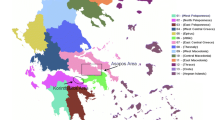Abstract
Managing water resources, in terms of both quality and quantity, in transboundary rivers is a difficult and challenging task that requires efficient cross-border cooperation and transparency. Groundwater pollution risk assessment and mapping techniques over the full catchment area are important tools that could be used as part of these water resource management efforts, to estimate pollution pressures and optimize land planning processes. The Evros river catchment is the second largest river in Eastern Europe and sustains a population of 3.6 million people in three different countries (Bulgaria, Turkey and Greece). This study provides detailed information on the main pollution sources and pressures in the Evros catchment and, for the first time, applies, assesses and evaluates a groundwater pollution risk mapping technique using satellite observations (Landsat NDVI) and an extensive dataset of field measurements covering different seasons and multiple years. We found that approximately 40 % of the Greek part of the Evros catchment is characterized as of high and very high pollution risk, while 14 % of the study area is classified as of moderate risk. Both the modeled and measured water quality status of the river showed large spatiotemporal variations consistent with the strong anthropogenic pressures in this system, especially on the northern and central segments of the catchment. The pollutants identified illustrate inputs of agrochemicals and urban wastes in the river. High correlation coefficients (R between 0.79 and 0.85) were found between estimated pollution risks and measured concentrations of those chemical parameters that are mainly attributed to anthropogenic activities rather than in situ biogeochemical processes. The pollution risk method described here could be used elsewhere as a decision support tool for mitigating the impact of hazardous human activities and improving management of groundwater resources.












Similar content being viewed by others
References
Aller, L., Bennett, T., Lehr, J.H., Petty, R.J., Hackett, G., 1987. DRASTIC: A Standardized System for Evaluating Groundwater Pollution Potential using Hydrogeologic Settings. US Environmental Protection Agency Rep EPA-600/2-87-035.
Andreo, B., Goldscheider, N., Vadillo, I., Vias, J.M., Neukum, C., Sinreich, M., Jimenez, P., Brechenmacher, J., Carrasco, F., Hotzl, H., Perles, M.J., Zwahlen, F., 2006. Karst groundwater protection: first application of a Pan-European approach to vulnerability, hazard and risk mapping in the Sierra de Lýbar (Southern Spain). Science of the Total Environment 357, 54-73.
Eaking, H., Luers A., 2006. Assessing the vulnerability of social-environmental systems. Annual Review of Environment and Resources 31(1), 365–94.
Erdogan S, 2010, Modelling the spatial distribution of DEM error with geographically weighted regression: An experimental study. Computers & Geosciences, 36, pp. 34–43.
Mennis J., 2006, Mapping the Results of Geographically Weighted Regression. The Cartographic Journal, 43, pp. 171–179.
Foster, S., 1987. Fundamental concepts in aquifer vulnerability, pollution risk and protection strategy. In: Van Duijvenbooden W, Van Waegeningh HG (eds), Vulnerability of soil and groundwater to pollutants. Proc Inf TNO Comm Hydrol Res, The Hague 38:69–86.
Fotheringham A. S., Brunsdon, C., and Charlton, M. E., 2002, Geographically Weighted Regression: The Analysis of Spatially Varying Relationships, Wiley, Chichester.
Han K.-S., Champeaux J.-L., Roujean J.-L., 2004, A land cover classification product over France at 1 km resolution using SPOT4/VEGETATION data. Remote Sensing of Environment, 92, pp. 52-66.
Günesf, E. H., Günes, Y., Talınıe, I., 2008. Toxicity evaluation of industrial and land base sources in a river basin, Desalination 226, 348–356.
Keiner L. E. and Yan X., 1998. A neural network model for estimating sea surface chlorophyll and sediments form Thematic Mapper imagery. Remote Sensing of Environment, 66, pp. 153–165.
Kocaman, I., Konukcu, F., Istanbulluoglu, A., 2007. Research on the sedimentation and erosion problem of the Ergene river basin in Western Turkey and precautions to control it. Eurasian Soil Science 40 (10), 1110–1116.
Lathrop R.G., Lillesand T.M. and Yandell B.S., 1991. Testing the utility of simple multi-date thematic mapper calibration algorithms for monitoring turbid inland waters. International Journal of Remote Sensing, 10, pp. 2045–2063.
Lillesand, T.M. and Kiefer, R.W., 1994, Remote Sensing and image interpretation, third edition, John Wiley & Sons Inc., New York.
Nikolaidis, C., Mandalos, P., Vantarakis, A., 2008. Impact of intensive agricultural practices on drinking water quality in the Evros Region (NE Greece) by GIS analysis. Environmental Monitoring Assessment 143, 43-50.
Jaimes N.B.P., Sendra J.B., Delgado M.G., Plata R.F., 2010. Exploring the driving forces behind deforestation in the state of Mexico using geographically weighted regression. Applied Geography, 30 (4), pp. 576-591.
Pant T., Dharmendra S., Tanuja S., 2010, Advanced fractal approach for unsupervised classification of SAR images. Advances in Space Research, 45, pp. 1338–1349.
Rizman Krista Z., 2008, An efficient k-means clustering algorithm. Pattern Recognition Letters, 29, pp. 1385–1391.
Rogerson P., 2001, Statistical Methods for Geography. SAGE Publications, London.
Roselló, P., Martinez, V., Navarro, A., 2009. Vulnerability of human environment to risk: Case of groundwater contamination risk. Environment International 35 (2), 325-335.
Skoulikidis, N., Economou, A., Gritzalis, K., Zogaris S., 2009. Rivers of the Balkans. In: Tockner, K., Uehlinger, U., Robinson, C.T. (Eds.). Academic Press, first ed., Rivers of Europe, UK, pp. 421-466.
Skoulikidis, N., Gritzalis, K., Kouvarda, Th., 2002. Hydrochemical and ecological quality assessment of a Mediterranean river system. GlobalNest 4(1): 29-40.
Skoulikidis, N., 1993. Significance evaluation of factors controlling river water composition. Environmental Geology 22, 178–185.
Tu J, Zong-Guo X, 2008, Examining spatially varying relationships between land use and water quality using geographically weighted regression I: Model design and evaluation. Science of the total environment, 407, pp. 358-378.
Zwahlen, F., 2004. Vulnerability and risk mapping for the protection of carbonate (karst) aquifers. Final report of COST Action 620. European Commission, Directorate-General XII.
Acknowledgments
This work was supported by Grants FP7-MC-IRG-208841 and MEXT-CT-2006-038331.
Author information
Authors and Affiliations
Corresponding author
Rights and permissions
About this article
Cite this article
Elias, D., Angeliki, M., Vasiliki, M. et al. Geospatial Investigation into Groundwater Pollution and Water Quality Supported by Satellite Data: A Case Study from the Evros River (Eastern Mediterranean). Pure Appl. Geophys. 171, 977–995 (2014). https://doi.org/10.1007/s00024-012-0621-2
Received:
Revised:
Accepted:
Published:
Issue Date:
DOI: https://doi.org/10.1007/s00024-012-0621-2




